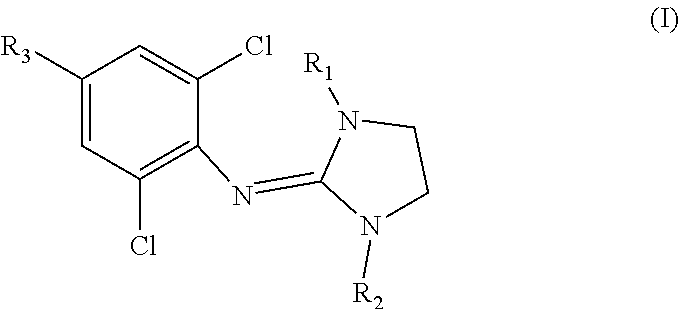Clonidine and/or clonidine derivatives for use in the prevention of skin injury resulting from radiotherapy
a technology of clonidine and/or clonidine derivatives, which is applied in the direction of dermatological disorders, drug compositions, anti-noxious agents, etc., can solve the problems of affecting the growth of non-cancerous cells, keratinocyte irradiation negatively affecting skin regeneration, and affecting the dna of non-cancerous cells, so as to prevent skin injury and reduce mucositis. , the effect of preventing skin
- Summary
- Abstract
- Description
- Claims
- Application Information
AI Technical Summary
Benefits of technology
Problems solved by technology
Method used
Image
Examples
example 1
on of Mucoadhesive Tablets of Clonidine Hydrochloride
[0057]1A—Tablet Containing 0.1 mg Clonidine
[0058]0.1 mg (base equivalent) of clonidine hydrochloride was blended with 13 mg of dibasic calcium phosphate, 15 mg of microcrystalline cellulose, 40 mg of hydroxypropyl methyl cellulose, 1 mg of colloidal silica and 0.9 mg of magnesium stearate.
[0059]The mixture was then homogenized by sieving and 30 mg of milk protein concentrate was added and mixed with the initial mixture. The resulting composition was then compressed under sufficient pressure to form a tablet.
[0060]1B—Tablets Containing 0.05 and 0.1 mg Clonidine
[0061]An aqueous solution of clonidine hydrochloride was sprayed on a mixture composed of microcrystalline cellulose, milk protein concentrate and povidone. Granulation continued until enough cohesion of the powders was obtained. After drying and sieving, hydroxypropyl methyl cellulose was added to the granules and mixed until blend uniformity was obtained. Finally, magnesium...
example 2
e Treatment of Skin Injury
[0066]A phase II, multicentre, randomised, double-blind, placebo-controlled study was performed to compare the efficacy of mucoadhesive buccal tablets comprising 50 μg of clonidine hydrochloride applied once daily to that of placebo in the prevention and treatment of skin injury following radiotherapy in patients with head and neck cancer (suffering from a newly diagnosed squamous cell carcinoma of the oral cavity, oropharynx, hypopharynx or larynx). These patients received, within 15 weeks after curative surgery, a cumulative radiation dose of radiation ranging from 50 to 70 Gray in oral cavity, based on a daily dosing between 1.8 and 2.2 Gy, combined with platinum-based chemotherapy, based on a weekly or tri-weekly cycle. Clonidine was administered in the form of a mucoadhesive tablet that was applied into the mouth, on the upper gum, for about 30 seconds, after which it remained in place for several hours. The treatment with clonidine hydrochloride start...
PUM
| Property | Measurement | Unit |
|---|---|---|
| tautomer | aaaaa | aaaaa |
| areas | aaaaa | aaaaa |
| tautomers | aaaaa | aaaaa |
Abstract
Description
Claims
Application Information
 Login to View More
Login to View More - R&D
- Intellectual Property
- Life Sciences
- Materials
- Tech Scout
- Unparalleled Data Quality
- Higher Quality Content
- 60% Fewer Hallucinations
Browse by: Latest US Patents, China's latest patents, Technical Efficacy Thesaurus, Application Domain, Technology Topic, Popular Technical Reports.
© 2025 PatSnap. All rights reserved.Legal|Privacy policy|Modern Slavery Act Transparency Statement|Sitemap|About US| Contact US: help@patsnap.com



